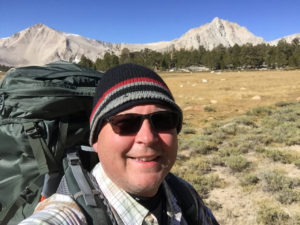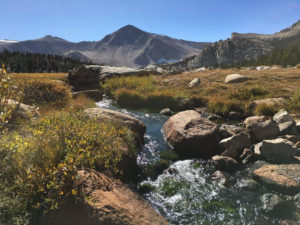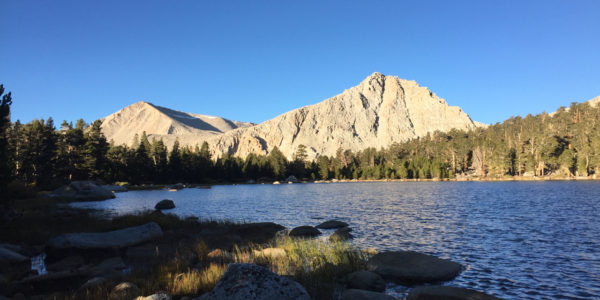I recently returned from a hiking trip through the John Muir Wilderness in the Sierra Mountains of California, just a few hours from my home. This was a multi-day trip that I have planned for several months with one of my adult step-sons, who recently wanted to take up hiking.
Now I have a hiking buddy 🙂
Reflecting on my experience before, during, and now after the hike, I am reminded again of how the risk management processes we use in business can also be applied to our personal life (I’ll have to be brief with my thoughts or else this e-mail will turn into a whole book).
Here are a couple of lessons that were reiterated with this experience.
- Have a Clear Objective and Strategy
- Assess and Plan
- Don’t Do It Alone
- Be Ready for Change
- Have a Clear Objective and Strategy

Clear Objective and Strategy
We were clear on what we wanted to achieve. Get out in nature. Spend a couple of nights camping. Physical exercise through hiking. Get some experience at higher elevations to prepare us for hiking Mount Whitney this next year (the highest mountain in the continental US).
To meet the objective we had to develop a strategy. We found a time on both of our calendars when we could take the multi-day trip. We found a trail route in the Sierra that was a loop of 20-25 miles that we could hike over the course of a couple days, which seemed reasonable based on our 8-14 mile day trips we had been taking. We charted out each day on the journey after reading maps and reviews of other hikers on the internet.
Assess and Plan
We live at sea level in the Los Angeles area, and knew our hike would be between 10,000 to 12,000 feet. At that altitude it is much more difficult to breath, so we decided to spend one night at the trailhead to help our bodies adjust to the altitude before the strenuous activity of hiking.
I kept checking the weather forecast for the town of Lone Pine, CA near where we would enter the Sierra Mountain Range, and we were planning accordingly. This was the closest town to where we would be hiking and the weather showed high temperatures around 75F and lows of 50F. Not too much different than our weather in Los Angeles.
We went on a 9 mile overnight hike in the Los Angeles area to practice setting up camp and dealing with the weight of full backpacks. I did my morning walks for a week through my neighborhood with my full pack. We made changes based on our experience and felt pretty confident in our planning based on our assessment.
The problem I realized a few days before we left was the significant difference in elevation of Lone Pine (approximately 4,000 feet) versus the trailhead camp and trail we would be on that ranged from 10,000 to 12,000 feet. The qualitative data I had used in my assessment was wrong, so we needed to adjust.
At this point I checked the closest higher elevation area with a weather forecast, which is Mount Whitney (14,505 ft), the tallest peak in the continental US and only a few miles away. What I found instead were forecasts with a high of 40F and a low of 8F (for those of you outside the US that is a range of 4C to -13C).
Based on this new information, we needed to change our plan (e.g. our water bottles would need to be in our sleeping bags overnight so we didn’t wake up to ice, etc…) and did so based on this new information.

Don’t Do It Alone
If you have heard me speak, I am sure you heard this before.
Whenever we are trying to accomplish something that is long, difficult or new, we should rely on others’ help.
At high altitude, and in cold conditions, it was necessary for us to rely on each other. We needed to watch out for signs of hypothermia and altitude sickness.
Anyone who travels to altitudes of over 8,000 feet is at risk of acute mountain sickness. The most prominent symptom of altitude sickness is usually headache, and most people also experience nausea and even vomiting, lethargy, dizziness and poor sleep.
Signs and symptoms of hypothermia include: shivering; slurred speech or mumbling; slow, shallow breathing; weak pulse; clumsiness or lack of coordination; drowsiness or very low energy; confusion or memory loss; and loss of consciousness.
Someone with hypothermia usually isn’t aware of his or her condition because the symptoms often begin gradually. Also, the confused thinking associated with hypothermia prevents self-awareness and can lead to risk-taking behavior (e.g. taking off one’s clothes).
Luckily for me, my step-son is a paramedic (although he reminds me he is off-duty).
Be Ready for Change
The poet Robert Burns said, “the best laid schemes of mice and men, go often askew.” For all of our planning, we did not anticipate high winds, nor how much the altitude would affect us in our hike.
For those of you not familiar with wind chill factors, at 25F a 10 mph wind feels like 10F and a 15 mph wind feels like 0F. Although we had planned for colder temperatures, we had not planned for the wind chill factor.
We were also not able to cover as much mileage per day as expected, so mid-afternoon of the first day we had to make a decision. Do we try to make the full loop, or take a different route and return sooner than expected. Once we passed a certain part in our journey, the only way out was the full loop.
We considered the forces and events we had not anticipated (e.g. the wind) and realized we needed to make a decision.
When we decided to make the change, it was necessary to re-check our objective. Would we still be able to achieve our objective if we cut our trip short by one day? The answer after we discussed was yes. We could still achieve our objective, and make a safe decision, so we changed our course.
Adjusting for Next Time
The process doesn’t end there. Now that we had more information, as a result of our experience, we could now make better decisions on our next trip. Early in my life I was taught: “when you know better, you do better.” With new information we could make better decisions in the future and improve upon our process. We are now one step closer to conquering Mount Whitney this next year.
Whether you are climbing mountains, navigating your way to meeting company objective, or trying to meet your own personal goals, the process and methodology we learn in risk management help us be successful. Remember to:
- Identify forces and events,
- Assess and evaluate the impacts of those events
- Anticipate and respond using proactive, detective and responsive actions and controls
- Monitor your progress and be ready for change
and you will achieve your goals and objectives.
